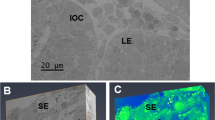Abstract
Connective tissue microfibrils were observed in tissues prepared with methods believed to minimize the loss of tissue components. The eyes of C57BL/6J mice were fixed with glutaraldehyde followed by either freeze substitution, or embedding in glycol methacrylate, a water-miscible embedding medium, after limited or no dehydration. In these preparations, microfibrils were present within sheet-like layers observed in the posterior chamber of the eye. The material enclosing the microfibrils that formed the layer was also preserved, at least partially, by fixation of the tissue with uranyl acetate or potassium permanganate (KMnO4) as observed in the chick eye. This microfibril-associated material was found to be composed of heparan sulfate proteoglycan (HSPG) as shown by positive immunostaining for HSPG, as well as by identification of 4.5 nm-wide HSPG double tracks as its major constituent. When a considerable amount of this material was lost in KMnO4-fixed tissues, the remaining portion was preserved in the form of clusters of about 50 nm in width which were periodically adhered along the length of microfibrils. At the center of each cluster, a minute dark particulate structure was present. It was composed of an approximately 10 nm-wide polygonal assembly of 3.5 nm-wide ring-like structures, and was, in unfixed chick eyes, positively immunostained for fibrillin. The periodicity of HSPG clusters, and of fibrillin, along the length of immunostained microfibrils was similar, ranging from 45 nm to 65 nm. These observations indicate that fibrillin is periodically associated at the surface of “classical” microfibrils, and it may mediate the association of large amounts of HSPG to microfibrils.
Similar content being viewed by others
References
Breathnach SM, Pepys MB, Hintner H (1989) Tissue amyloid P component in normal human dermis is non-covalently associated with elastic fiber microfibrils. J Invest Dermatol 92: 53–58
Chan FL, Inoue S, Leblond CP (1993) The basement membranes of cryofixed or aldehyde-fixed, freeze-substituted tissues are composed of a lamina densa and do not contain a lamina lucida. Cell Tissue Res 273:41–52
Elder HY (1989) Cryofixation. In: Bullock GR, Pretusz P (eds) Techniques in Immunocytochemistry, vol 4. Academic Press. San Diego, pp 1–28
Harvey DMR (1981) Freeze-substitution. J Microsc 127:209–221
Hayat MA (1970) Principles and Techniques of Electron Microscopy. Biological Applications. Vol. 1. Van Nostrand Reinhold, New York, pp 112–117
Inoue S (1991) Pentosomes — a new connective tissue component — is a subunit of amyloid P. Cell Tissue Res 263:431–438
Inoue S (1994) Ultrastructure of connective tissue microfibrils in the posterior chamber of the eye in vivo and in vitro. Cell Tissue Res 279:291–302
Inoue S, Leblond CP (1986) The microfibrils of connective tissue: I. Ultrastructure. Am J Anat 176:121–138
Inoue S, Leblond CP, Grant DS, Rico P (1986) The microfibrils of connective tissue: II. Immunohistochemical detection of the amyloid P component. Am J Anat 176:139–152
Inoue S, Grant D, Leblond CP (1989a) Heparan sulfate proteoglycan is present in basement membrane as a double-tracked structure. J Histochem Cytochem 37:597–602
Inoue S, Leblond CP, Rico P, Grant D (1989b) Association of fibronectin with the microfibrils of connective tissue. Am J Anat 186:43–54
Keene DR, Maddox BK, Kuo H-J, Sakai LY, Granville RW (1991) Extraction of extendable beaded structures and their identification as fibrillin-containing extracellular matrix microfibrils. J Histochem Cytochem 39:441–449
Khan AM, Walker F (1984) Age related detection of tissue amyloid P in the skin. J Pathol 143:183–186
Laurie GW, Leblond CP, Martin GR (1982) Localization of type IV collagen, laminin, heparan sulfate proteoglycan, and fibronectin to the basal lamina of basement membranes. J Cell Biol 95:340–344
Maddox BK, Sakai LY, Keene DR, Glanville RW (1989) Connective tissue microfibrils. Isolation and characterization of three large pepsin-resistant domains of fibrillin. J Biol Chem 264 21381–21385
Matoltsy AG, Gross J, Grignolo A (1951) A study of the fibrous components of the vitreous body of the electron microscope. Proc Soc Exp Biol Med 76:857–860
Sakai LY, Keene DR, Engvall E (1986) Fibrillin, a new 350-kD glycoprotein, is a component of extracellular microfibrils. J Cell Biol 103:2499–2509
Todd ME, Tokito MK (1981) Improved ultrastructural detail in tissues fixed with potassium permanganate. Stain Technol 56: 335–342
Volker W, Schmidt A, Buddecke E (1987) Mapping of proteoglycans in human arterial tissue. Eur J Cell Biol 45:72–79
Wallace RN, Streeten BW, Hanna RB (1991) Rotary shadowing of elastic system microfibrils in the ocular zonule, vitreous, and ligamentum nuchae. Curr Eye Res 10:99–109
Wright DW, Mayne R (1988) Vitreous humor of chicken contains two fibrillar systems: an analysis of their structure. J Ultrastruct Molec Struct Res 100:224–234
Author information
Authors and Affiliations
Rights and permissions
About this article
Cite this article
Inoue, S. Ultrastructural and immunohistochemical studies of microfibril-associated components in the posterior chamber of the eye. Cell Tissue Res 279, 303–313 (1995). https://doi.org/10.1007/BF00318486
Received:
Accepted:
Issue Date:
DOI: https://doi.org/10.1007/BF00318486




